|
|
|
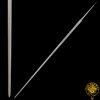 |
|
| Hanwei Live Rapier Blade (OH2327) |
Points: 4
|
Live Rapier Blade for rapiers: Renaissance Style Swept Hilt Rapier (SH1024), Bone Handled Swept Hilt Rapier (SH1092), Solingen Rapier (SH2205, SH2205N), Torino Rapier (SH2204, SH2204N), Gustav Rapier (SH2206, SH2206N).
|
|
|
|
|
|
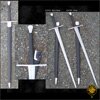 |
|
| Hanwei Longsword - Tinker Pearce Blunt Trainer (SH2395) |
Points: 13

|
The Blunt Trainer longsword features nearly identical handling of its sharp companion, but with thick edges (2mm) and a rounded tip for safe sparring practice.
Tinker Pearce has developed these matching longswords to satisfy the need of every Western Martial Arts practitioner and sword enthusiast, to have a matching set of sharp and blunt swords for cutting and safe training practice. The swords meet Tinker`s exacting quality requirements and are built in much the same way as his custom pieces. Each blade is forged from 5160 Spring Steel, Marquenched to the desired hardness of 50-53 Hrc while the tang is drawn back to the low 30s Hrc. Teh very end of the tang is threaded to fit an allen nut recessed into the pommel which allows for dimantling of the hilt assembly for inspection or to exchange blades if needed.
What others are saying about the Tinker Pearce Longswords:
"I had the opportunity to handle the prototype Tinker Pearce Line Longswords by CAS/Hanwei, and they are beautiful, well-balanced, quick-handling swords at an excellent price. The sharp and blunt versions handle almost identically in cuts, thrusts, and quick posta (guard) transitions. These promise to be the mid-priced training weapon of choice for longsword studies."
Sean Hayes, Maestro d`armi, Northwest Fencing Academy and University of Oregon
|
|
|
|
|
|
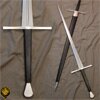 |
|
| Hanwei Longsword - Tinker Pearce Sharp (SH2394) |
Points: 15

|
Tinker Pearce has developed these matching longswords to satisfy the need of every Western Martial Arts practitioner and sword enthusiast, to have a matching set of sharp and blunt swords for cutting and safe training practice. The swords meet Tinker`s exacting quality requirements and are built in much the same way as his custom pieces. Each blade is forged from 5160 Spring Steel, Marquenched to the desired hardness of 50-53 Hrc while the tang is drawn back to the low 30s Hrc. The very end of the tang is threaded to fit an allen nut recessed into the pommel which allows for dimantling of the hilt assembly for inspection or to exchange blades if needed.
|
|
|
|
|
|
 |
|
| Hanwei Main Gauche (matches SH1092) (SH2197) |
Points: 8
|
Our Renaissance-style Swept Hilt Rapiers trace their origins to early 17th century Europe, where swordplay with the Rapier was considered an essential part of a gentleman's education and was often used in resolving gentlemanly disagreements. Blades generally originated in one of the blade making centers such as Toledo or Solingen, but many differences in styling and hilt materials resulted from the local manufacture of hilts all over Europe. The Main Gauche, or left hand dagger, was often used with the rapier, providing an added dimension in both offense and defense, and the "Schools of Fence" which proliferated in Europe during this period taught the use of the two weapons in combination. The Main Gauche would often match the Rapier in styling, while incorporating features which maximized the effectiveness of the piece.
|
|
|
|
|
|
 |
|
| Hanwei Main Gauche - Wood Grip (matches SH1024) (SH2198) |
Points: 10
|
Our Renaissance-style Swept Hilt Rapiers trace their origins to early 17th century Europe, where swordplay with the Rapier was considered an essential part of a gentleman's education and was often used in resolving gentlemanly disagreements. Blades generally originated in one of the blade making centers such as Toledo or Solingen, but many differences in styling and hilt materials resulted from the local manufacture of hilts all over Europe. The Main Gauche, or left hand dagger, was often used with the rapier, providing an added dimension in both offense and defense, and the "Schools of Fence" which proliferated in Europe during this period taught the use of the two weapons in combination. The Main Gauche would often match the Rapier in styling, while incorporating features which maximized the effectiveness of the piece.
|
|
|
|
|
|
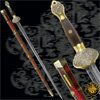 |
|
| Hanwei Ming Sword (SH2006) |
Points: 70
|
The pattern of the Ming Sword dates from the Ming Dynasty (1368 AD -- 1644 AD), which ruled China for almost three centuries after the fall of the Mongol controlled Yuan Dynasty. The beauty of this delightfully compact sword centers on its superb pattern-welded K120C blade, forged with a ridged central fuller providing the stiffness required for thrusting and the lightness required for speed. The grip is sculpted from brown buffalo horn, which is also used in thin, translucent wafers as a shell for the intricately decorated scabbard. The brass fittings are selectively decorated with dynastic designs plated in silver.
Recreated by the craftsmen of CAS Hanwei from the swords of the Lords of the great dynasties, these Chinese Gongfu swords represent the pinnacle of the sword maker's art, vividly illustrating the skills and creativity of the smiths of Imperial China.
|
|
|
|
|
|
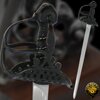 |
|
|
|
|
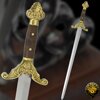 |
|
|
|
|
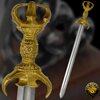 |
|
|
|
|
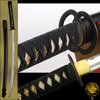 |
|
| Hanwei Musashi Iaito |
Points: 28
|
The Musashi Iaito provides an economical yet authentic sword for the Iaido practitioner. Available in 3 blade lengths (27, 28, 29) to perfectly match your needs. The blade is unedged for safety and forged from steel for more precise weight and balance than an aluminum blade can offer. The blade is also maintenance free, providing a lifetime of practice without worry of rust or tarnish. Miyamoto Musashi, arguably the most famous swordmaster in Japanese history, fought more than 60 duels before retiring and writing his famous treatise on swordplay, the "Book of Five Rings". Development of the two-sword style of swordplay, with the Daito (long sword) and Wakizashi being used together, is credited to Musashi. Mounted in black, the Musashi Elite is faithful to the original down to the famous double-ring iron tsubas. The tsuka-ito is in leather over ray skin.
|
|
|
|
|
|
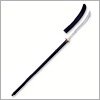 |
|
| Hanwei Naginata (SH1020) |
Points: 25

|
The Naginata, famed weapon of the Sohei, or warrior monks, of medieval Japan was fearsome in the hands of a skilled combatant and is today of great importance in the martial arts field. Our naginata (SH1020), while retaining its traditional qualities, has been revised to better meet the needs of the martial arts practitioner. Hand forged 1065 high-carbon steel and edge tempered, using a traditional claying method, the naginata blade is at least the equal of the originals. Mounted on a long tang to better absorb the shock of a blow, the blade has a strong distal taper for balance and quickness. The delicately engraved tsuba features a silver butterfly motif. The one-piece staff (ebu) is very strong, featuring a traditional tear-drop cross-section for easy recognition of blade orientation and a black non-slip finish for better control of the weapon. The naginata is supplied with a wooden saya, a protective cloth bag and a boxed maintenance kit.
Hand forged high-carbon steel blade
Edge tempered
Tear-drop cross-section for correct blade orientation
|
|
|
|
|
|
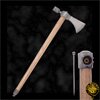 |
|
| Hanwei Pipe Hawk (smokable) (XH2119) |
Points: 4
|
Replicating a museum piece from the days of trade between the French fur trappers and the American Indians, our Pipe Hawk (XH2119) is fully functional both as a hatchet and a pipe, with a steel blade, bowl and mouthpiece. As in the original, a reaming pin (for clearing the smoke passage) is concelaed in the head of the end of the shaft.
|
|
|
|
|
|
 |
|
| Hanwei Practical Basket Hilt Backsword (SH2075) |
Points: 15

|
The Practical Mortuary Hilt and Practical Basket-Hilt swords are built for the re-enactor. The baskets are identical to the edged versions, but the blades are unsharpened, with 1/16" safety edges and rounded tips, complying with the combat rules of many re-enactment societies. The blades are crafted in 1065 high-carbon steel, hardened to 50HRC, which reduces edge-notching to acceptable levels while providing resilience and protection against brittleness. The scabbards are finished in matte black, ready for owner customization if desired.
|
|
|
|
|
|
 |
|
| Hanwei Practical Basket Hilt Broadsword (SH2059) |
Points: 15
|
The Practical Mortuary Hilt and Practical Basket-Hilt swords are built for the re-enactor. The baskets are identical to the edged versions, but the blades are unsharpened, with 1/16" safety edges and rounded tips, complying with the combat rules of many re-enactment societies. The blades are crafted in 1065 high-carbon steel, hardened to 50HRC, which reduces edge-notching to acceptable levels while providing resilience and protection against brittleness. The scabbards are finished in matte black, ready for owner customization if desired.
|
|
|
|
|
|
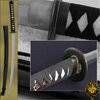 |
|
| Hanwei Practical Elite Katana - 27 inch (SH6000KPC) |
Points: 17

|
The blade is forged and differentially tempered, using the same process as the more expensive blades and producing an HRC60 edge and HRC40 back. The temper line is authentic and prominent. Cost savings are effected by using fittings which, while making no claims to authenticity, are very strongly built to withstand the rigors of cutting exercises in the dojo.
Forged high-carbon steel blade
Differential tempering
Hanwei made
|
|
|
|
|
|
|
|
Tags:
swords, sword, katana, wakizashi, tanto, japanese sword, medieval sword, viking sword, japanese swords, medieval swords, viking swords, knife, knives, saber, armour, movie swords, movie replicas, martial arts, sporting goods, sporting equipment,
|

















